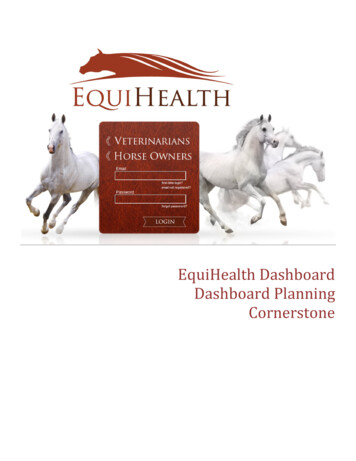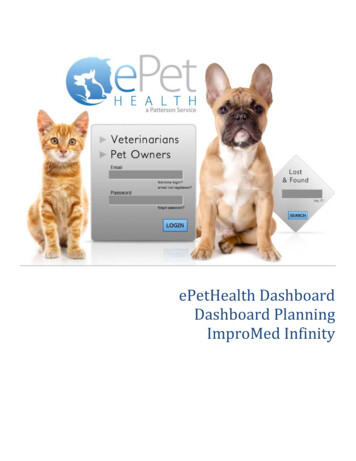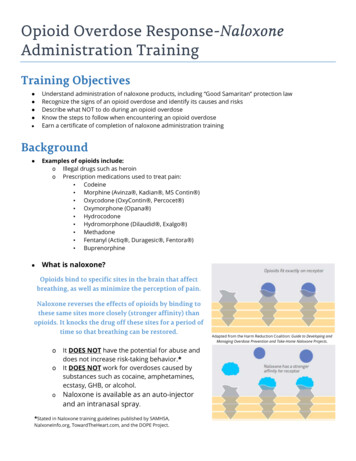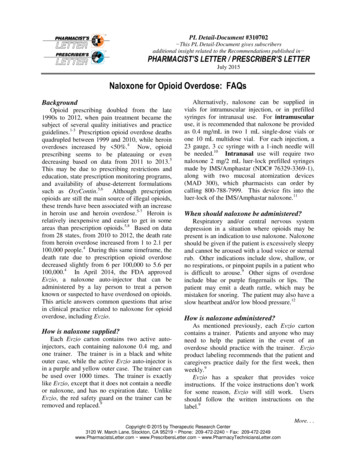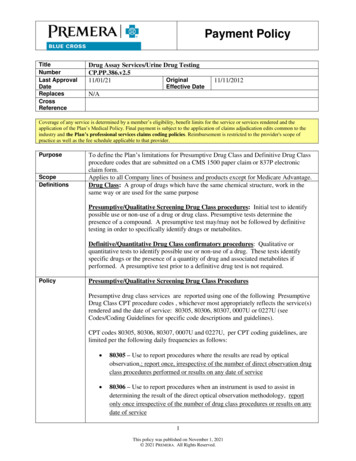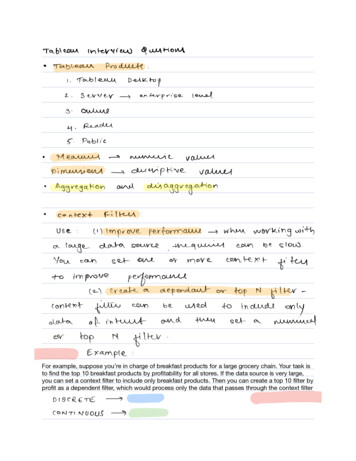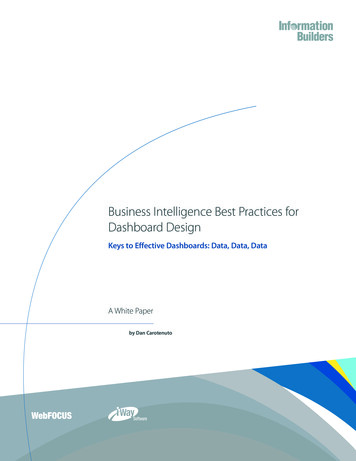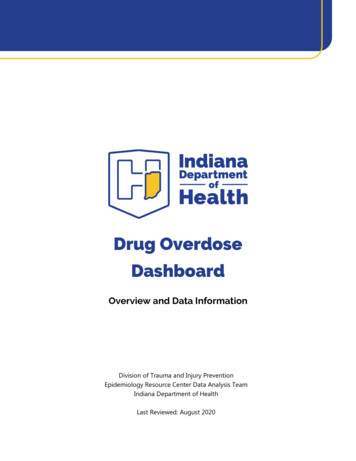
Transcription
Drug OverdoseDashboardOverview and Data InformationDivision of Trauma and Injury PreventionEpidemiology Resource Center Data Analysis TeamIndiana Department of HealthLast Reviewed: August 2020
IntroductionDrug overdose injuries have been a growing public health concern over the past decade bothnationally and in Indiana. Drug overdose injuries have lasting effects on the well-being offamilies and communities. An important part of drug overdose prevention efforts isunderstanding the trends and regional and demographic differences that may exist. Access todata from a variety of sources is key to supporting both state and local overdose response andprevention activities.This dashboard shows drug overdose injuries in different ways and can be used to driveinterventions and assist in drug overdose education and prevention efforts. Although the factorsthat contribute to drug overdose injuries are largely known, this dashboard highlights theproblems and issues that affect people living in Indiana. For more data on drug overdoseinjuries, please visit the Indiana Department of Health’s Drug Overdose Prevention Website.If you need immediate help, Call 2-1-1 or click here to connect with help.Call the Indiana Addiction Hotline at 1-800-662-HELP (4357) or visit here to live chat witha representative.Through a partnership between Indiana 211 and OpenBeds, people seeking treatment forsubstance use disorder can be immediately connected with available inpatient orresidential treatment services.Dashboard Data SourcesThis dashboard was a collaboration between the Indiana State Department of Health’s (ISDH’s)Division of Vital Records, Epidemiology Resource Center’s Data Analysis Team, Fatality ReviewDivision, Division of Trauma and Injury Prevention and other state agencies such as theManagement Performance Hub (MPH), Indiana Professional Licensing Agency and IndianaHospital Association. The data source for the deaths by drug poisoning (overdose) is the vitalrecords mortality data for 2016, 2017, 2018 and 2019. The data source for hospitalizations andemergency department visits due to drug poisoning is the Indiana Hospital Association’sdischarge data for 2016, 2017, 2018 and 2019. The data source for the opioid prescriptiondispensation data is from the INSPECT PDMP program in conjunction with MPH for 2017, 2018,2019, and 2020. For more information or questions about this data, please contacttrauma@isdh.in.gov.Vital Records (Vital Statistics) Mortality DataDeath certificate data are used to track underlying and contributing cause of death, in order tounderstand the burden of drug overdose deaths for prevention. Data are collected by the ISDHDivision of Vital Records. A final dataset is provided by the ISDH, Epidemiology Resource Center,
Data Analysis Team and analyzed by the Division of Trauma and Injury Prevention to identifyoverdose deaths among Indiana residents. Deaths are reported back to the county of residenceof the Indiana decedent.Vital statistics mortality data includes up to 20 causes of death. Frequencies are based on thedecedent’s county of residence, not the county where death occurred. The dashboard’s mortalitydata reflects definitions of drug poisoning (overdose) and contributing involved drugs based onguidance provided by the Centers for Disease Control and Prevention (CDC) and the NationalCenter for Health Statistics (see Tables 1 and 2). Rates based on counts less than 20 areconsidered unstable/unreliable (U) and should be interpreted with caution. Age-adjusted rateper 100,000 was calculated using the 2000 Standard Million Population, U.S. Bureau of Census.To avoid over-counting the number of drug deaths, counts from various drug categories shouldnot be added to counts from other categories as multiple drugs can be listed on the deathcertificate for drug poisoning deaths, and deaths can be included in more than one of thesetables for deaths from certain drugs and drug types.Mortality data reported in this dashboard may vary from the data shared on the Stats Explorerwebsite as the dashboard portrays age-adjusted rates and the Stats Explorer website primarilyportrays crude rates for the following data elements. Dashboard reviewers should be aware ofthese differences when comparing the website data elements. The identified overdose cases arebased on ICD-10 codes derived from the death certificate information recorded by countycoroners or medical examiners. Because overdose is a sensitive topic, and findings by thecoroner or medical examiner may be subjective or under-investigated, there may be underreporting of overdose-involved cases.The identified overdose cases for the involvement of specific drugs are based on ICD-10 codesderived from the death certificate information recorded by county coroners or medicalexaminers. Because toxicology testing availability and toxicology testing interpretation wasvariable prior to 2018, drug specificity on death certificates by the coroner or medical examinermay be subjective or under-reported, causing an under-reporting of the specific drugs involvedin an overdose.Data is reported by county of residence of the decedent, which may or may not be where thedeath occurred. When reviewing the data collected by county coroners, reviewers should beaware that county coroners report death counts based on county of occurrence and theirinterpretation of the deaths they certify.All drug overdose death counts do not include alcohol as a primary substance of inclusion.
Table 1. Drug Poisoning (Overdose) Definitions for Vital Statistics Mortality DataDefinitionAccidental poisoning by drugsIntentional self-poisoning by drugsAssault by drug poisoningDrug poisoning of undetermined intentUnderlying Cause of Death ICD-10 CodesX40-X44X60-X64X85Y10-Y14Table 2. Drug Poisonings (Overdoses) Involving Specific Drug Categories Definitions forVital Statistics Mortality DataDefinitionDrug overdose death involving any opioidDrug overdose death involving an opioid painrelieverDrug overdose death involving syntheticopioidsDrug overdose death involving heroinDrug overdose death involvingbenzodiazepinesDrug overdose deaths involving cocaineDrug overdose deaths involvingpsychostimulants other than cocaine(primarily amphetamines/methamphetamines)Contributing Cause of Death ICD-10 CodesAny underlying cause code as listed abovewith any of the additional contributing causecodes of:T40.0 (opium), T40.1 (heroin), T40.2 (naturaland semisynthetic opioids), T40.3(methadone), T40.4 (synthetic opioids), T40.6(other unspecific narcotic)Any underlying cause code as listed abovewith any of the additional contributing causecodes of:T40.2 (natural and semisynthetic opioids),T40.3 (methadone), T40.4 (synthetic opioids)Any underlying cause code as listed abovewith the additional contributing cause codeof:T40.4 (synthetic opioids)Any underlying cause code as listed abovewith the additional contributing cause codeof:T40.1 (heroin)Any underlying cause code as listed abovewith the additional contributing cause codeof:T42.4 (benzodiazepines)Any underlying cause code as listed abovewith the additional contributing cause codeof:T40.5 (cocaine)Any underlying cause code as listed abovewith the additional contributing cause codeof:T43.6 (psychostimulants other than cocaine)
Indiana Hospital Discharge (Morbidity) DataThe Indiana hospitalizations and emergency department (ED) visit data are a subset of datacompiled from the Uniform Billing 2004 form. The inpatient (hospitalizations) data containIndiana residents discharged from a non-federal, acute care facility who were admitted to thehospital. The outpatient (ED visits) data contain Indiana residents discharged from a non-federal,acute care facility who received emergency services without being admitted to the hospital. Thedata are supplied by the Indiana Hospital Association under a contract with ISDH. Data areprocessed by the ISDH, Epidemiology Resource Center, Data Analysis Team to provide a datasetthat is analyzed by the Hospital Discharge Data Analyst in conjunction with the Division ofTrauma and Injury Prevention.Each hospitalization and ED visit are assigned ICD-10-CM codes for the principal reason and upto 59 secondary reasons for the hospital visit. Statistics in these dashboards are based on all 60diagnoses, and the frequencies are based on the decedent’s county of residence, not the countywhere the event occurred. The dashboard’s morbidity data reflects definitions of drug poisoning(overdose) and contributing involved drugs based on guidance provided by the CDC (see Table3). Rates based on counts less than 20 are considered unstable/unreliable (U) and should beinterpreted with caution. Age-adjusted rate per 100,000 was calculated using the 2000 StandardMillion Population, U.S. Bureau of Census. To avoid over-counting the number of drug-relatedevents, counts from various drug categories should not be added to counts from othercategories as multiple drugs can be listed on the billing codes for drug poisoning events, andevents can be included in more than one of these tables for discharges from certain drugs anddrug types. An individual can have more than one hospitalization or ED visit during thereporting time frame. Frequencies and rates are based on the number of discharges and not onthe number of individuals seen.Morbidity rates reported in this dashboard vary from the data shared on the Stats Explorerwebsite, as the dashboard portrays age-adjusted rates rather than crude population rates.Dashboard reviewers should be aware of this difference when comparing the website dataelements.Table 3. Non-fatal Drug Poisoning (Overdose) Definitions for Indiana Hospital DischargeMorbidity DataDefinitionAll drug overdose emergency CM Codes[T36.x-T50.x] (1A): Unintentional Poisoning bydrug; initial encounter[T36.x-T50.x] (2A): Self-Harm Poisoning bydrug; initial encounter[T36.x-T50.x] (4A): Undetermined Poisoningby drug; initial encounter
Emergency department visits/hospitalizationsinvolving any opioidEmergency department visits/hospitalizationsinvolving opioid pain relieversEmergency department visits/hospitalizationsinvolving heroinEmergency department visits/hospitalizationsinvolving cocaineEmergency department visits/hospitalizationsvisits involving synthetic opioidsEmergency department visits involvingbenzodiazepinesEmergency department visits involvingpsychostimulants[T40.0, T40.1, T40.2, T40.3, T40.4, T40.60,T40.69] (1A): Unintentional Poisoning bydrug; initial encounter[T40.0, T40.1, T40.2, T40.3, T40.4, T40.60,T40.69] (2A): Self-Harm Poisoning by drug;initial encounter[T40.0, T40.1, T40.2, T40.3, T40.4, T40.60,T40.69] (4A): Undetermined Poisoning bydrug; initial encounter[T40.2, T40.3, T40.4] (1A): UnintentionalPoisoning by drug; initial encounter[T40.2, T40.3, T40.4] (2A): Self-HarmPoisoning by drug; initial encounter[T40.2, T40.3, T40.4] (4A): UndeterminedPoisoning by drug; initial encounter[T40.1] (1A): Unintentional Poisoning by drug;initial encounter[T40.1] (2A): Self-Harm Poisoning by drug;initial encounter[T40.1] (4A): Undetermined Poisoning bydrug; initial encounter[T40.5] (1A): Unintentional Poisoning by drug;initial encounter[T40.5] (2A): Self-Harm Poisoning by drug;initial encounter[T40.5] (4A): Undetermined Poisoning bydrug; initial encounter[T40.4] (1A): Unintentional Poisoning by drug;initial encounter[T40.4] (2A): Self-Harm Poisoning by drug;initial encounter[T40.4] (4A): Undetermined Poisoning bydrug; initial encounter[T42.4] (1A): Unintentional Poisoning by drug;initial encounter[T42.4] (2A): Self-Harm Poisoning by drug;initial encounter[T42.4] (4A): Undetermined Poisoning bydrug; initial encounter[T43.6] (1A): Unintentional Poisoning by drug;initial encounter[T43.6] (2A): Self-Harm Poisoning by drug;initial encounter
[T43.6] (4A): Undetermined Poisoning bydrug; initial encounterOpioid Prescription Dispensations (INSPECT) DataOpioid prescription dispensations to Indiana residents is collected from the Indiana ScheduledPrescription Electronic Collection and Tracking Program (INSPECT) from the ManagementPerformance Hub and shared with the ISDH Division of Trauma and Injury Prevention.Dispensation data includes three opioid prescription categories: opioid analgesics, opioidantidiarrheals/antitussives, and opioid antagonists and treatment addiction medications.Data is reported by county of residence of the patient who received the dispensation, and thismay or may not be where the prescription was written or filled. Statistical unit is PrescriptionRate per 1,000. Statistical unit is crude rate per 1,000 and is not adjusted for age or terminalillness diagnosis. County numbers are approximate as some patients receiving a dispensationare missing a designated county FIPS code. The denominator for the years 2017 and 2018 arebased on the U.S. Bureau of Census 2016 estimate population counts for Indiana and its countypopulations. 2019 and 2020 denominators are based on 2018 U.S. Bureau of Census estimatepopulation counts for Indiana and its county populations. Data may include naloxone; however,naloxone is not an opioid but an opioid antagonist (opioid overdose reversal drug). Data isinclusive of methadone but are not methadone prescriptions related to opioid treatmenttherapy that is delivered by opioid treatment programs. Data is also inclusive of non-humansubject dispensations. Data will differ from data reported by the CDC for various reasons such asthe inclusion of non-human subject prescriptions, different data sources and the types of opioidprescriptions included. Data reviewers should be aware of these when analyzing the data.Contact InformationFor more information or questions about this data, please contact trauma@isdh.in.gov
emergency department visits due to drug poisoning is the Indiana Hospital Association’s discharge data for 2016, 2017, 2018 and 2019. The data source for the opioid prescription . Dashboard reviewers should be aware of this difference when comparing the website data elements. Table 3
